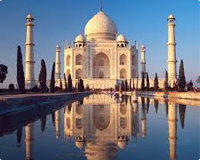Agra
 Agra , the former capital of Hindustan, is a city on the banks of the river Yamuna in the northern state of Uttar Pradesh, India. It is 363 kilometres (226 mi) west of the state capital, Lucknow, and 200 kilometres (124 mi) south of the national capital New Delhi. With a population of 1,686,976 (2010 est.), it is one of the most populous cities in Uttar Pradesh and the 19th most populous in India. Agra can also refer to the administrative district that has its headquarters in Agra city.
Agra , the former capital of Hindustan, is a city on the banks of the river Yamuna in the northern state of Uttar Pradesh, India. It is 363 kilometres (226 mi) west of the state capital, Lucknow, and 200 kilometres (124 mi) south of the national capital New Delhi. With a population of 1,686,976 (2010 est.), it is one of the most populous cities in Uttar Pradesh and the 19th most populous in India. Agra can also refer to the administrative district that has its headquarters in Agra city.
Tourist attractions :
Taj Mahal : The Taj Mahal is one of the most famous buildings in the world, the mausoleum of Shah Jahan's favourite wife, Mumtaz Mahal. It is one of the New Seven Wonders of the world, and one of the three World Heritage Sites in Agra.
Tombs of Shah Jahan and his beloved wife, Mumtaz Mahal. Completed in 1653, the Taj Mahal was built by the Mughal king Shah Jahan as the final resting place for his beloved wife, Mumtaz Mahal. Finished in marble, it is perhaps India's most fascinating and beautiful monument. This perfectly symmetrical monument took 22 years (1630-1652) of labour and 20,000 workers, masons and jewellers to build and is set amidst landscaped gardens. Built by the Persian architect, Ustad 'Isa, the Taj Mahal is on the south bank of the Yamuna River. It can be observed from Agra Fort from where Emperor Shah Jahan gazed at it for the last eight years of his life, a prisoner of his son Aurangzeb. It is an acknowledged masterpiece of symmetry. Verses of the Koran are inscribed on it and at the top of the gate are twenty-two small domes, signifying the number of years the monument took to build. The Taj Mahal was built on a marble platform that stands above a sandstone one. The most elegant dome of the Taj Mahal has a diameter of 60 feet (18 m), and rises to a height of 80 feet (24 m); directly under this dome is the tomb of Mumtaz Mahal. Shah Jahan's tomb was erected next to hers by his son Aurangzeb. The interiors are decorated with fine inlay work, incorporating semi-precious stones.
Agra Fort :
Agra Fort (sometimes called the Red Fort), was commissioned by the great Mughal Emperor Akbar in 1565, and is another of Agra's World Heritage Sites. A stone tablet at the gate of the Fort states that it had been built before 1000 but was later renovated by Akbar. The red sandstone fort was converted into a palace during Shah Jahan's time, and reworked extensively with marble and pietra dura inlay. Notable buildings in the fort include the Pearl Mosque or Moti Masjid, the Diwan-e-'Am and Diwan-e-Khas (halls of public and private audience), Jahangir's Palace, Khas Mahal, Shish Mahal (mirrored palace), and the Musamman Burj.
The forbidding exteriors of this fort conceal an inner paradise. The fort is crescent shaped, flattened on the east with a long, nearly straight wall facing the river. It has a total perimeter of 2.4 kilometres (1.5 mi), and is ringed by double castellated ramparts of red sandstone punctuated at regular intervals by bastions. A moat 9 metres (30 ft) wide and 10 metres (33 ft) deep surrounds the outer wall.
Fatehpur Sikri : The Mughal Emperor Akbar built Fatehpur Sikri about 35 km (22 mi) from Agra, and moved his capital there. Later abandoned, the site displays a number of buildings of significant historical importance. A World Heritage Site, it is often visited by tourists. The name of the place came about after the Mughal Emperor Babar defeated Ra?a Sanga in a battle at a place called Sikri (about 40 km (25 mi) from Agra). Then the Mughal Emperor Akbar wanted to make Fatehpur Sikri his head quarters, so he built a majestic fort; due to shortage of water, however, he had to ultimately move his headquarters to Agra Fort.











 Manali
Manali

